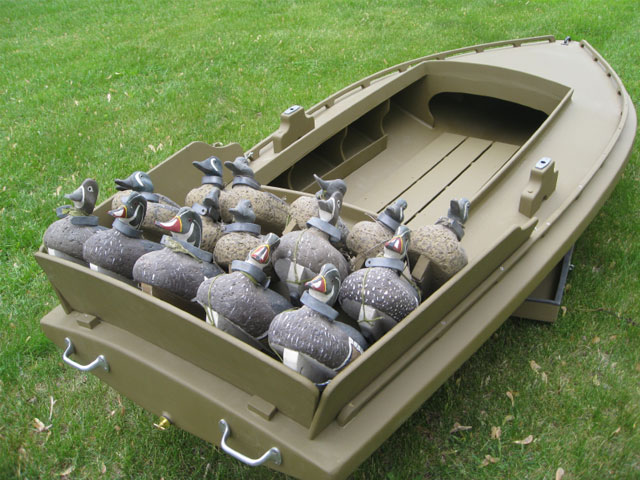
Build Your Own Camouflaged Duck Boat: Wooden Plans for DIY Hunters
There's nothing quite like the thrill of a successful duck hunt, especially when you've built your own boat. This article will walk you through the process of constructing a durable and effective duck boat using wood. Whether you're a seasoned hunter or a novice, these detailed plans will guide you towards creating a vessel that will blend seamlessly into the environment and bring you closer to your quarry.
Choosing the Right Wood
The heart of your duck boat lies in the wood you choose. Marine-grade plywood is your best bet, as it's resistant to moisture and decay, making it perfect for the harsh conditions of a hunting environment. Consider using plywood with a thickness of at least 1/2 inch for optimal strength and stability.
Types of Wood
For the hull, marine-grade plywood is the go-to choice. Consider using a layer of marine-grade plywood for the outer hull and another layer of plywood for the inner hull for added durability. You can choose between various types of marine-grade plywood, such as fir, oak, or cedar, depending on your budget and preference. When purchasing plywood, ensure it's stamped with the Marine Plywood Association (MPA) certification mark.
For structural elements like the gunwales, ribs, and seats, you can opt for solid hardwoods like oak, cedar, or mahogany. These woods provide strength and a natural resistance to moisture, enhancing the longevity of your duck boat.
Building the Hull
Before you begin building, it's crucial to have a detailed plan. You can either find readily available plans online or create your own. Ensure your plan outlines the boat's dimensions, the shape of the hull, and the placement of all structural components. This will serve as your guide throughout the building process.
Cutting and Shaping
Use a circular saw or a table saw to cut the plywood sheets according to the dimensions outlined in your plans. For intricate curves, utilize a jigsaw or a band saw. Sand the edges of the cut pieces to ensure a smooth and even surface.
Assembling the Hull
Start by assembling the bottom of the hull. Secure the plywood sheets together using marine-grade epoxy and screws. For added reinforcement, consider using fiberglass cloth and epoxy along the seams. Once the bottom is complete, attach the sides of the hull to the bottom. Remember to leave an opening for the deck and for access to the interior.
Adding Structural Components
The strength and stability of your duck boat hinge on the structural components like gunwales, ribs, and seats. These elements help maintain the boat's shape and distribute the weight evenly.
Gunwales
Gunwales run along the upper edges of the hull, providing a secure perimeter for the boat and supporting the deck. Cut and shape your chosen hardwood to the desired length and width. Use screws and epoxy to attach them to the sides of the hull.
Ribs
Ribs are strategically placed along the length of the boat, providing internal support and maintaining the shape of the hull. They're typically made from wooden planks that are curved and attached to the gunwales and the hull. You can use screws and epoxy to secure the ribs in place.
Seats
Comfortable and sturdy seats are essential for a successful duck hunt. You can build simple benches or create more elaborate seats with backrests using your chosen hardwood. Securely attach the seats to the boat's interior using screws and epoxy.
Camouflaging Your Duck Boat
The final step is to camouflage your duck boat, making it virtually invisible to wary ducks. This involves covering the boat's exterior with a suitable material that blends into the surroundings.
Choosing Camouflage Material
You have a wide range of options when it comes to camouflage material. Consider using natural materials like reeds, cattails, and branches. Alternatively, you can opt for commercially available camouflage netting or paint that mimics the colors and patterns of the environment where you'll be hunting.
Applying Camouflage
To ensure a seamless camouflage effect, secure the chosen material to the boat's exterior using zip ties, screws, or staples. Ensure the material is distributed evenly, covering the entire surface. You can also use spray adhesive for a more permanent and robust camouflage.
Safety Considerations
Safety should always be paramount when hunting. Ensure your duck boat is equipped with essential safety gear, including:
- Life jackets
- An anchor
- A whistle
- A first aid kit
- A flashlight
- A fire extinguisher
Always inspect your duck boat before each hunt to ensure all components are secure and in good condition.
Final Touches
After completing the build, you can add personal touches to your duck boat. Consider installing a small storage compartment for gear, adding a built-in cooler, or creating a custom-designed gun rack. The possibilities are endless, allowing you to personalize your duck boat to your specific needs.
Building your own camouflaged duck boat can be a rewarding experience, allowing you to create a hunting vessel that's tailored to your specific needs. This DIY project will not only save you money but also give you a sense of pride and accomplishment. Remember to prioritize safety, and with careful planning and execution, you'll have a duck boat that will serve you well for years to come.

0 comments:
Post a Comment